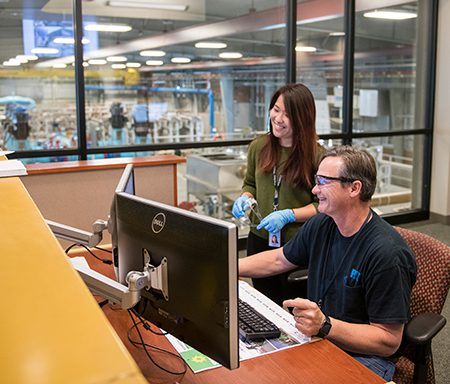Utility Risk & Resilience Certificate Program


Strengthen Utility Resilience
Updated for the 2025-2026 AWIA Cycle
The Safe Drinking Water Act (SDWA), through America’s Water Infrastructure Act (AWIA) of 2018, requires community water systems serving more than 3,300 people to develop and update Risk and Resilience Assessments (RRAs) and Emergency Response Plans (ERPs) every five years. These updates must address threats from malevolent acts and natural hazards. They must also include strategies to improve system resilience across physical, operational, and cyber domains.
To support utilities in meeting the regulatory obligations of SDWA Sec. 1433 (AWIA Sec. 2013), the AWWA Utility Risk & Resilience Certificate Program offers a structured, standards-based learning pathway. This program equips water professionals and consultants with the tools and knowledge needed to conduct comprehensive RRAs and ERPs that align with AWIA Section 2013 requirements.
Utility Risk & Resilience: an AWWA eLearning Certificate Program
This certificate program includes six self-paced, online eLearning courses. These courses support water utility professionals in developing a comprehensive, all-hazards approach to risk and resilience management. Learners can access the content on demand and progress through each course at their own convenience.
Course material is grounded in key AWWA standards and technical resources, including ANSI/AWWA G430, ANSI/AWWA G440, ANSI/AWWA J100, and AWWA’s Cybersecurity Guidance. These resources provide a solid foundation for conducting effective risk and resilience assessments and developing robust emergency response plans.
Although not required, it is suggested that the courses be taken in sequential order. The program begins with the free certificate program overview course, Facilitating Compliance with America’s Water Infrastructure Act (EL260).
Program Course Descriptions & Registration
Package of All Six Courses
This certificate program will provide a foundation for supporting a water utility’s development of an all-hazards approach to risk and resilience management. Students will learn about AWIA requirements for risk and resilience assessments and emergency response plans. Course content will include examples of how utilities can apply the various AWWA standards and resources to aid compliance with AWIA.
EL265 includes the following six eLearning courses:
- Facilitating Compliance with America’s Water Infrastructure Act of 2018 | EL260
- Security Practices for Operations and Management | EL261
- Risk and Resilience for Water and Wastewater Systems | EL262
- Emergency Planning | EL263
- Cybersecurity in the Water Sector eLearning Course | EL264
- Water Sector Resource Typing Guidance and Implementation Toolkit | EL305
Free Course: Facilitating Compliance with America’s Water Infrastructure Act of 2018 | EL260
This complimentary course defines the AWIA requirements for community water systems and introduces all utilities to the standards and resources designed to improve resiliency and manage risks for all-hazards. After learning how to comply with the AWIA mandate, course participants will understand how existing standards and resources can be applied by utilities to lower risk and fortify their resilience.
1 hour | Free
Security Practices for Operations and Management | EL261
Course length: 1 Hour
This course demonstrates how water and wastewater utility participants can integrate security and preparedness into the culture of their organization. The course also provides examples of best practices for all-hazards risk and resilience based on sections of the AWWA G430 Standard, “Security Practices for Operation and Management.”
Module 1: Elements of a Risk and Resilience Management Strategy
Module 2: Resources for Developing and Maintaining a Risk and Resilience Management Strategy
Module 3: Summary of How a Risk and Resilience Management Strategy Facilitates AWIA Compliance
Learning Objectives:
- Comprehend the commitment, culture, and employee expectations in a risk and resilience management strategy
- Recognize the 13 elements of a risk and resilience management strategy
- Understand the concepts of detect, deter, devalue, delay, and respond
- Identify resources for developing a risk and resilience management strategy
- Recognize the applications and use of resource tools and where to find them
- Recognize how to achieve a risk and resilience management strategy, and how this facilitates AWIA compliance
Risk and Resilience for Water & Wastewater Systems | EL262
Course length: 4 Hours
This course will provide participants with an awareness-level understanding of the J100 Standard for Risk and Resilience Management of Water and Wastewater Systems (J100) and how it can be used to improve resilience at any utility, as well as support the statutory mandate for community water systems described in America’s Water Infrastructure Act (AWIA) of 2018 (P.L. 115-270).
Module 1: Overview of J100
Module 2: Developing Threat – Asset Pairs
Module 3: Defining Baseline Risks through Consequence, Vulnerability, and Threat Likelihood Analyses
Module 4: Risk and Resilience Management
Learning Objectives:
- Understand all 7 steps of the J100 process
- Select critical assets
- Identify common threats and hazards
- Describe how to conduct preliminary screening of Threat-Asset Pairs
- Name the types of consequences that should be considered
- Conduct an example baseline risk calculation
- Recognize mitigation measures that provide a positive Benefit/Cost Ratio
- Prioritize mitigation measures into phases
Cybersecurity in the Water Sector | EL264
Cybersecurity is the top threat facing business and critical infrastructure in the U.S., according to reports and testimony from the Director of National Intelligence, the Federal Bureau of Investigation and the Department of Homeland Security. All water systems should act to examine cybersecurity vulnerabilities and develop a cybersecurity risk management program.
The Cybersecurity in the Water Sector (EL264) course is designed to provide the knowledge and skills needed to recognize gaps in a utility’s cybersecurity coverage, and show actionable steps to manage a water utility’s cybersecurity risk. This course is part of AWWA’s Risk and Resilience Certificate Program that examines all hazards in developing risk and resilience assessments and emergency response plans.
This course is also designed to teach participants how to use the AWWA Water Sector Cybersecurity Risk Management Tool.
2 hours | $90 member, $115 non-member
Emergency Planning | EL263
This course provides an overview of emergency preparedness, response planning, ANSI/AWWA G440 Emergency Preparedness Practices and M19 Emergency Planning for Water and Wastewater Utilities. This course will equip water and wastewater utilities to apply the content of these standards along with other current industry best practices, to develop an emergency preparedness program, as well as an Emergency Response Plan (ERP), that improve resiliency while reducing risk. The information from this course will assist utilities to meet the requirement for water systems to develop an emergency plan, as described in America’s Water Infrastructure Act (AWIA) of 2018. Upon completion of this course, participants should be able to undertake the hands-on development of an ERP for their utility or effectively manage that development by an outside party.
2 hours | $90 member, $115 non-member
Free Course: Water Sector Resource Typing Guidance & Implementation Toolkit | EL305
This course is designed to support water utility implementation of resource typing as a key element of emergency response planning, including provisions in AWIA section 2013. Resource typing, also known as identifying and typing resources, in the preparedness phase is a foundation of effective resource management for requesting or providing mutual aid and assistance. The objective is for a utility or jurisdiction to assess and inventory internal resources to determine their capacity to respond to incidents and identify resources that may be necessary to address potential gaps.
Resource typing is an essential building block of successful preparedness planning and mutual aid during emergency response. Successful adoption of an effective resource typing program will provide the water sector with a thorough understanding of the response capability within a system, identify essential response equipment, develop essential personnel, and staff response teams, which can, in turn, increase the resilience and effectiveness of the utility and allow the utility to support others during an incident.
Advertisement
